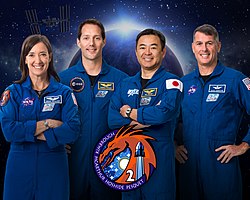- Crew-2 astronauts walk out from the O&C Building
- Launch of Crew-2
- Crew Dragon Endeavour approaching the ISS
- View of the ISS from Endeavour
- Crew-2 reentering the atmosphere
- Crew Dragon Endeavour on MV GO Navigator after splashdown
 Endeavour approaches the ISS | |
| Names |
|
|---|---|
| Mission type | ISS crew transport |
| Operator | SpaceX |
| COSPAR ID | 2021-030A |
| SATCAT no. | 48209 |
| Mission duration | 199 days, 17 hours, 44 minutes, 13 seconds |
| Spacecraft properties | |
| Spacecraft | Crew Dragon Endeavour |
| Spacecraft type | Crew Dragon |
| Manufacturer | SpaceX |
| Launch mass | 12,055 kg (26,577 lb) [1] |
| Landing mass | 9,616 kg (21,200 lb) |
| Crew | |
| Crew size | 4 |
| Members | |
| Expedition | Expedition 65/66 |
| Start of mission | |
| Launch date | April 23, 2021, 09:49:02 UTC (5:27:17 am EDT) [2] |
| Rocket | Falcon 9 Block 5 B1061-2 |
| Launch site | Kennedy, LC‑39A |
| End of mission | |
| Recovered by | MV GO Navigator |
| Landing date | November 9, 2021, 03:33:15 UTC (10:33:15 am EST) |
| Landing site | Gulf of Mexico, near Pensacola, Florida |
| Orbital parameters | |
| Reference system | Geocentric orbit |
| Regime | Low Earth orbit |
| Inclination | 51.66° |
| Docking with ISS | |
| Docking port | Harmony forward |
| Docking date | April 24, 2021, 09:07:55 UTC |
| Undocking date | July 21, 2021, 10:45 UTC |
| Time docked | 88 days, 1 hour, 37 minutes |
| Docking with ISS (relocation) [a] | |
| Docking port | Harmony zenith |
| Docking date | July 21,2021,11:36 UTC |
| Undocking date | November 8,2021,19:05 UTC [5] |
| Time docked | 110 days,7 hours,29 minutes |
    From top to bottom,left to right:NASA, [6] SpaceX,JAXA,and ESA mission patches  From left:McArthur,Pesquet,Hoshide and Kimbrough | |
SpaceX Crew-2 was the second operational flight of a Crew Dragon spacecraft,and the third overall crewed orbital flight of the Commercial Crew Program. The mission was launched on April 23,2021,at 09:49:02 UTC,and docked to the International Space Station on April 24 at 09:08 UTC. [2]
Contents
SpaceX Crew-2 used the same capsule as Crew Dragon Demo-2 (Endeavour) and launched on the same Falcon 9 booster as SpaceX Crew-1 (B1061.1).
With its return to Earth the evening of November 9,2021,the mission set a record for the longest spaceflight by a U.S. crewed spacecraft with a mission duration of 199 days before being surpassed by SpaceX Crew-8 with a mission duration of 235 days respectively. [7]








